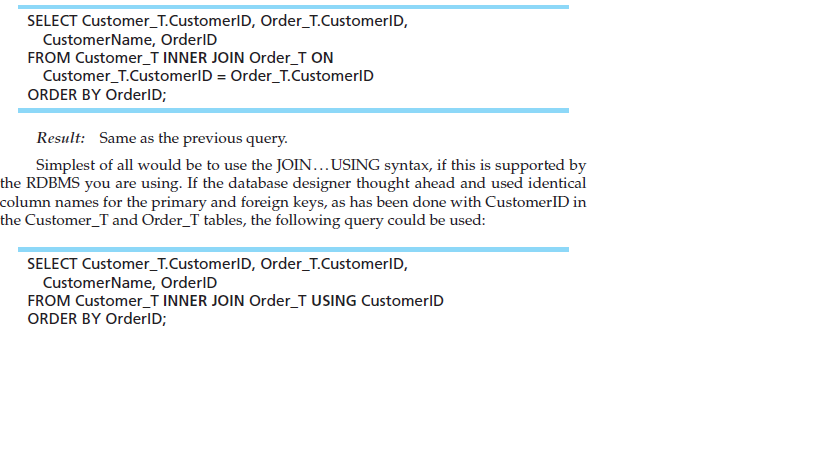SELECT Customer_T.CustomerlD, Order_T.CustomerID, CustomerName, OrderID FROM Customer_T INNER JOIN Order_T ON Customer_T.CustomerID = Order_T.CustomerlD ORDER BY OrderlD; Result: Same as the previous query. Simplest of all would be to use the JOIN...USING syntax, if this is supported by the RDBMS you are using. If the database designer thought ahead and used identical column names for the primary and foreign keys, as has been done with CustomerlID in the Customer_T and Order_T tables, the following query could be used: SELECT Customer_T.CustomerlD, Order_T.CustomerID, CustomerName, OrderID FROM Customer_T INNER JOIN Order_T USING CustomerlD ORDER BY OrderID;
SELECT Customer_T.CustomerlD, Order_T.CustomerID, CustomerName, OrderID FROM Customer_T INNER JOIN Order_T ON Customer_T.CustomerID = Order_T.CustomerlD ORDER BY OrderlD; Result: Same as the previous query. Simplest of all would be to use the JOIN...USING syntax, if this is supported by the RDBMS you are using. If the database designer thought ahead and used identical column names for the primary and foreign keys, as has been done with CustomerlID in the Customer_T and Order_T tables, the following query could be used: SELECT Customer_T.CustomerlD, Order_T.CustomerID, CustomerName, OrderID FROM Customer_T INNER JOIN Order_T USING CustomerlD ORDER BY OrderID;
Computer Networking: A Top-Down Approach (7th Edition)
7th Edition
ISBN:9780133594140
Author:James Kurose, Keith Ross
Publisher:James Kurose, Keith Ross
Chapter1: Computer Networks And The Internet
Section: Chapter Questions
Problem R1RQ: What is the difference between a host and an end system? List several different types of end...
Related questions
Question
What are the customer IDs and names of all customers, along with the order IDs for all the orders they have placed?

Transcribed Image Text:SELECT Customer_T.CustomerlD, Order_T.CustomerID,
CustomerName, OrderID
FROM Customer_T INNER JOIN Order_T ON
Customer_T.CustomerID = Order_T.CustomerlD
ORDER BY OrderlD;
Result: Same as the previous query.
Simplest of all would be to use the JOIN...USING syntax, if this is supported by
the RDBMS you are using. If the database designer thought ahead and used identical
column names for the primary and foreign keys, as has been done with CustomerlID in
the Customer_T and Order_T tables, the following query could be used:
SELECT Customer_T.CustomerlD, Order_T.CustomerID,
CustomerName, OrderID
FROM Customer_T INNER JOIN Order_T USING CustomerlD
ORDER BY OrderID;
Expert Solution
This question has been solved!
Explore an expertly crafted, step-by-step solution for a thorough understanding of key concepts.
This is a popular solution!
Trending now
This is a popular solution!
Step by step
Solved in 2 steps

Recommended textbooks for you

Computer Networking: A Top-Down Approach (7th Edi…
Computer Engineering
ISBN:
9780133594140
Author:
James Kurose, Keith Ross
Publisher:
PEARSON

Computer Organization and Design MIPS Edition, Fi…
Computer Engineering
ISBN:
9780124077263
Author:
David A. Patterson, John L. Hennessy
Publisher:
Elsevier Science

Network+ Guide to Networks (MindTap Course List)
Computer Engineering
ISBN:
9781337569330
Author:
Jill West, Tamara Dean, Jean Andrews
Publisher:
Cengage Learning

Computer Networking: A Top-Down Approach (7th Edi…
Computer Engineering
ISBN:
9780133594140
Author:
James Kurose, Keith Ross
Publisher:
PEARSON

Computer Organization and Design MIPS Edition, Fi…
Computer Engineering
ISBN:
9780124077263
Author:
David A. Patterson, John L. Hennessy
Publisher:
Elsevier Science

Network+ Guide to Networks (MindTap Course List)
Computer Engineering
ISBN:
9781337569330
Author:
Jill West, Tamara Dean, Jean Andrews
Publisher:
Cengage Learning

Concepts of Database Management
Computer Engineering
ISBN:
9781337093422
Author:
Joy L. Starks, Philip J. Pratt, Mary Z. Last
Publisher:
Cengage Learning

Prelude to Programming
Computer Engineering
ISBN:
9780133750423
Author:
VENIT, Stewart
Publisher:
Pearson Education

Sc Business Data Communications and Networking, T…
Computer Engineering
ISBN:
9781119368830
Author:
FITZGERALD
Publisher:
WILEY